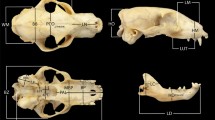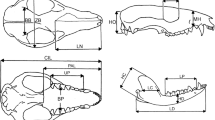Abstract
Metatherians experience the greatest developmental changes during extrauterine life. Following previous studies onDidelphis albiventris Lund, 1840, we examined the postweaning cranial allometry of size of the Neotropical marsupialLutreolina crassicaudata (Desmerest, 1804). Our aim was to compare growth patterns of both species to identify traits particular to each species and traits common to both species. This may contribute toward identifying a common developmental plan for didelphids. We measured 15 cranial variables in 32–43 specimens from just-weaned young to old adult. Total length of the skull was the estimator of overall size in least squares and reduced major axis regressions. The skull ofLutreolina crassicaudata grows at a rate slower than the overall change in size in its neurocranial components, palate, and postcanine rows, and it grows relatively faster in the rest of the splanchnocranium. This pattern closely resembles that ofDidelphis albiventris, from which it differs mainly in the allometry of the muzzle. In both species, allometry explains most postweaning changes of the trophic apparatus on functional grounds, in relation to interspecific differences in diet. We hypothesize that most local allometric departures from a generalized didelphid plan would relate to main dietary trends.
Similar content being viewed by others
References
Abdala F., Flores D. A. and Giannini N. P. 2001. Postweaning ontogeny of the skull ofDidelphis albiventris. Journal of Mammalogy 82: 190–200.
Alexander R. McN. 1985. Body support, scaling and allometry. [In: Functional vertebrate morphology. M. Hildebrand and D. B. Wake, eds]. The Belknap Press of Harvard University Press, Cambridge, Massachusetts: 27–37.
Barquez R. M., Mares M. A. and Ojeda R. A. 1991. Mammals of Tucumán. Oklahoma Museum of Natural History, Norman, Oklahoma: 1–282.
Crompton A. W. 1989. The evolution of mammalian mastication. [In: Complex organismal function: integration and evolution in vertebrates. D. B. Wake and J. Roth, eds]. John Wiley and Sons Ltd., New York: 23–40.
Crompton A. W. and Hiiemae K. 1970. Molar occlusion and mandibular movements during occlusion in the American opossum,Didelphis marsupialis L. Zoological Journal of the Linnean Society 49: 21–47.
Crompton A. W. and Hylander W. 1986. Changes in mandibular function following the acquisition of a dentary-squamosal jaw articulation. [In: The ecology and biology of mammal-like reptiles. N. Hotton III, P. D. MacLean, J. J. Roth and E. C. Roth, eds]. Smithsonian Institution Press, Washington, D.C.: 263–282.
Eisenberg J. F. 1989. Mammals of the Neotropics. Volume 1. The northern Neotropics: Panama, Colombia, Venezuela, Guyana, Suriname, French Guiana. The University of Chicago Press, Chicago, Illinois: 1–449.
Emerson S. B. and Bramble D. M. 1993. Scaling, allometry and skull design. [In: The skull. Volume 3. J. Hanken and B. K. Hall, eds]. The University of Chicago Press, Chicago, Illinois: 384–416.
Emerson S. B. and Radinsky L. 1980. Functional analysis of sabertooth cranial morphology. Paleobiology 6: 295–312.
Goin F. J. and Pardiñas U. F. J. 1996. Revisión de las especies deHyperdidelphis Ameghino, 1904 (Mammalia, Marsupialia, Didelphidae). Su significación filogenética, estratigráfica y adaptativa en el Neogeno del cono sur sudamericano. Estudios Geológicos 52: 327–359.
Goin F. J., Velásquez C. and Scaglia O. 1992. Orientación de las crestas cortantes en el molar tribosfénico. Sus implicancias funcionales en didelfoideos (Marsupialia) fósiles y vivientes. Revista del Museo de La Plata (Nueva Serie) 10: 183–189.
Graipel M., Miller P. R. M. and Ximénez A. 1996. [Contribution and distribution of the subspecies ofLutreolina crassicaudata (Desmarest) (Marsupialia, Mammalia)]. Revista Brasileira de Zoologia 13: 781–790. [In Portuguese]
Hair J. F. Jr, Anderson R. E., Tatham R. L. and Black W. C. 1995. Multivariate data analysis. Fourth ed. Prentice Hall, New Jersey: 1–745.
Jansa S. A. and Voss R. S. 2000. Phylogenetic studies on didelphid marsupials I. Introduction and preliminary results from nuclear IRBP gene sequences. Journal of Mammalian Evolution 7: 43–77.
Lillegraven J. A. 1976. Biological considerations of the marsupial-placental dichotomy. Evolution 29: 702–722.
Mares M. A., Ojeda R. and Bárquez R. M. 1989. Guide to the Mammals of the Salta province of Argentina. University of Oklahoma Press. Norman, Oklahoma: 1–303.
Niklas K. J. 1994. Plant allometry. The scaling of form and process. The University of Chicago Press, Chicago, Illinois: 1–395.
Redford K. H. and Eisenberg J. F. 1992. Mammals of the Neotropics. Volume 2. The southern Cone: Chile, Argentina, Uruguay, Paraguay. The University of Chicago Press, Chicago, Illinois: 1–435.
Simpson G. G., Roe A. and Lewontin R. C. 1960. Quantitative zoology. Harcourt, Brace and World, Inc., New York: 1–440.
Van Valen L. 1969. Evolution of dental growth and adaptation in mammalian carnivores. Evolution 23: 96–117.
Walker E. P. 1975. Mammals of the World. Third Edition. The Johns Hopkins University Press, Baltimore, Maryland: 1–1500.
Wroe S. 1997. A reexamination of proposed morphology-based synapomorphies for the families of Dasyuromorphia (Marsupialia). I. Dasyuridae. Journal of Mammalian Evolution 4: 19–52.
Author information
Authors and Affiliations
Rights and permissions
About this article
Cite this article
Flores, D.A., Giannini, N.P. & Abdala, F. Cranial ontogeny ofLutreolina crassicaudata (Didelphidae): a comparison withDidelphis albiventris . Acta Theriol 48, 1–9 (2003). https://doi.org/10.1007/BF03194261
Received:
Accepted:
Issue Date:
DOI: https://doi.org/10.1007/BF03194261




